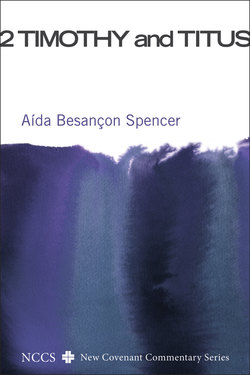Читать книгу 2 Timothy and Titus - Aída Besançon Spencer - Страница 8
На сайте Литреса книга снята с продажи.
Introduction to Titus
ОглавлениеSetting: Crete
Crete, in the Mediterranean Sea, 160 miles south of Athens, 200 miles north of Africa, is 160 miles long and 7 to 35 miles wide. It is a mountainous island with excellent shallow harbors. Ancient farmers grew wheat, barley, figs, olives, grapes, and tended to sheep and goats, and fish were plentiful.1 In Roman times Crete was covered with forests, now the interior mountains have few forests.2 Nevertheless, it has been called “the garden of the whole Universe,” for its “beauty, pleasure and profit.”3
Crete had a mixed culture with influence from Western Semites (Phoenicia, Syria, Israel), Egypt, Mesopotamia, Babylonia, Anatolia, Cyprus, and Greece. Jews lived in Crete as well. Ancient Cretans were known as a maritime people. Cretan archers were especially renowned and frequently hired as mercenaries. The society was organized very similar to Sparta’s, a communal society set up to train citizen-soldiers.4 Even the buildings were set up in a communal manner, with construction built around a central court. Streets would radiate out from the center of the palace.5
Minoan Crete had a predominance of female deities, including the Snake Goddess, protector of the household. But each new civilization brought its own deities. As in Ephesus, the goddess Artemis could be found.6 Cretans claimed that Zeus was born in a cave in Crete and that Crete was the birthplace of many deities.7
Although females in Crete did not have all the political rights that men had, in Minoan Crete women were probably the social equals of men and participated in all activities including the dangerous sport of vaulting over charging bulls.8
Analytical Outline of Titus
Paul’s overall purpose is for Titus “to set straight what was remaining” at the church in Crete in order to further the faith of God’s elect and their knowledge of the truth that accords with godliness.
I. Introduction: Paul writes Titus for the sake of the faith of God’s elect and the knowledge of the truth that is in accordance with godliness (1:1–4).
II. Paul left Titus behind to set straight what was remaining by appointing godly elders and rebuking ungodly people (1:5–16).
A. Paul left Titus in Crete to set straight what was remaining by appointing godly elders in every city (1:5–9).
B. Sound teaching is necessary to correct the many who are deceptive and need to be rebuked (1:10–14).
C. Although they claim to know God, their minds and consciences are defiled (1:15–16).
III. Paul wants Titus to teach what is consistent with healthy doctrine (2:1—3:11).
A. Paul wants Titus to promote healthy teaching by encouraging godly behavior among the elders, youth, and slaves (2:1–15).
B. Paul wants Titus to remind people to live godly lives in the world because they are justified by Christ’s grace (3:1–8).
C. Paul wants Titus to have nothing to do with anyone who causes divisions (3:9–11).
IV. Conclusion: Paul wants Titus to come to him and, by helping Zenas and Apollos, teach people to devote themselves to good works (3:12–15).
A. Paul wants Titus to come to him (3:12).
B. Titus, by helping Zenas and Apollos, needs to teach people to keep busy in good works (3:13–14).
C. Final greetings: Christians greet Titus and ask Titus to greet Christians in Crete (3:15).
1. Gordon 1987: 330; Vucinich and Vouras CE 7, 1987: 430; Branigan and Vickers 1980: 48–49. The author observed in a visit to Crete in May 2010 that olives, oranges, sheep, goats, and fish are still plentiful.
2. Strabo, Geogr. 10.4; Willetts 1965: 37–38. Crete was celebrated for its timber in Roman times (Hood 1971: 20).
3. William Lithgow, 1609, as cited by Hood 1971: 16.
4. OCD 1970: 298, 97.
5. Gordon 1987: 334; Branigan and Vickers 1980: 32.
6. Branigan and Vickers 1980: 44, 82; Nilsson 1971: 400, 405. According to Nilsson (509), the Minoan Mistress of Wild Nature developed into the Great Mother of Asia Minor (with lions) and the virgin huntress of Greece. The Minoans “personified the Supreme Principle as a woman to whom was subordinate a young male” (401).
7. E.g., Aratus, Phaen. 30–34; Callimachus’s Hymn. 1, Hymn. Jov. 6.33–34; Diodorus 5.64.2.
8. Gordon 1987: 332–33; Branigan and Vickers 1980: 41–43.
